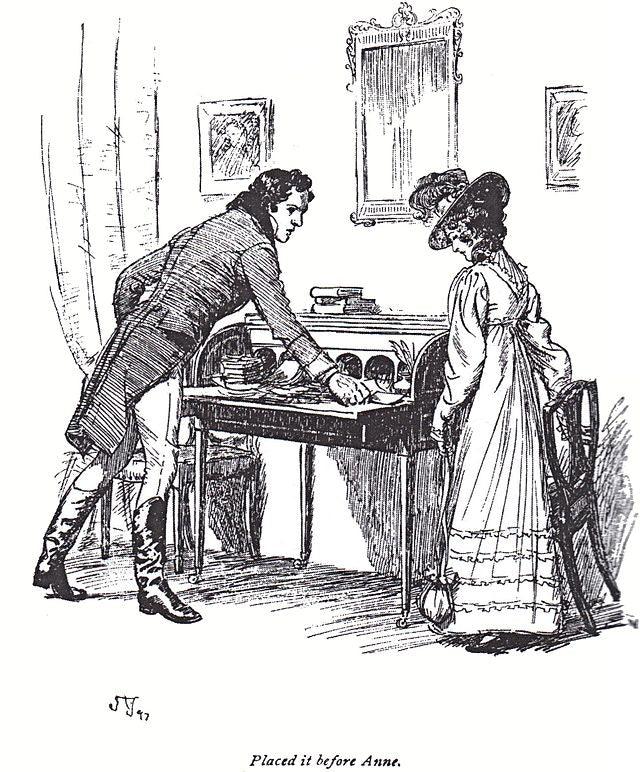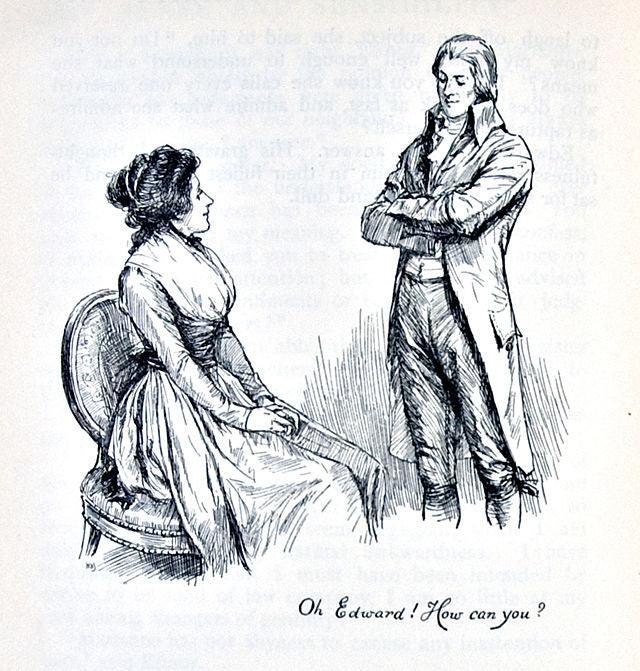
Duty and Desire in Persuasion
Accidents and Safe Spaces: How Anne Elliot and Frederick Wentworth Negotiate between Duty and Desire in Jane Austen’s Persuasion
Persuasion as Portrait of and Challenge to the Dichotomy of Gendered Spaces in England’s Regency Era
Persuasion, Jane Austen’s last novel, which was published posthumously in 18171, tells about Anne Elliot, a woman born to aristocracy in nineteen-century England, who, after having been persuaded by her “surrogate mother” Lady Russell, ended her engagement to Frederick Wentworth, a man with no connections, alliance or fortune, only to see him returning to her life eight years later as a successful naval officer in search of a wife, who still carries with him, the pain over the estrangement all those years ago.2
While on the surface, the novel can be read as a tale of a second chance at love, it can also be interpreted in many different ways due to the amalgamation of themes running alongside the main love story. For instance, literary critics have viewed Persuasion as a dramatization of the decaying of aristocracy and the emergence of the middle class.3 The novel is also considered as Jane Austen’s attempt to challenge the gendered spaces forced upon men and women of that era, limiting women’s realm in the domestic and men in the public sphere.4
Jane Austen’s observations on the gendered spaces in eighteenth and early nineteenth-century England are reflected in Anne Elliot’s musing to Captain Harville:
We (women) live at home, quiet, confined, and our feelings prey upon us… You (men) have always a profession, pursuits, business of some sort or other, to take you back into the world immediately.5
Anne Elliot’s remark is in line with the rules of Regency at the time that the primary concerns for particularly unmarried women are domestic affairs, such as taking care of their family, including tending to the sick, the young, and the aged.6 In contrast to the life of domesticity imposed on women, men are expected to occupy public spaces by conducting business outside the house, getting social stature, recognition, and making a fortune.
While the rigid dichotomy of spaces between men and women of that era is rightfully viewed as giving more freedom to men, it also has its limiting qualities. The desirable virtues of an English man of the period, as identified by writer Meaghan Malone are as follows:
The ideal man was virile and powerful but self-controlled; polite and chivalric but never effeminate; vigorous but not overly passionate, and always rational and intimately concerned with the affairs of Britain.7
Under the weight of these restrictive gendered spaces, Anne Elliot and Captain Wentworth are unable to express and communicate their desires for each other openly. For instance, as writer Kailey Rhone argues, Wentworth’s determination to conceal his vulnerability results from societal expectations of masculine stoicism.8 Similarly, Anne’s conformity to domestic duties as the nurturing caretaker of her sister Mary Musgrove and her nephews, as opposed to realizing her wants, can be viewed as the embodiment of socially-expected feminine values of the time.
However, as asserted by writer Kailey Rhode, there is an aspect of willingness in both Anne and Wentworth’s apparent submission to societal-gendered spaces, namely to sublimate their feelings to each other9, thus, making their submission to gendered practices merely a performative act. The depiction of the characters’ pretension of adhering to societal norms that limits their own freedom showcases Jane Austen’s distinctive literary technique, which utilizes a mix of, among others, parody and irony, which aim to challenge the gendered social norms of that time.10 In addition to the incorporation of irony, Jane Austen also uses encounters in the form of tragedy and accidents to force Anne and Wentworth to move out of their “safe spaces” – namely, the predefined gendered realms – and act on their desires. The main two accidents in Persuasion that I believe provide the stage for them to occupy and defy their places in society are the accidents involving Mary Musgrove’s son in Uppercross and the fall of Louisa Musgrove in Lyme, which I will elaborate in the next section.
Safe Spaces and the Accidents that Render Them Unhabitable
Both Anne Elliot and Captain Wentworth suffer heartbreak after the dissolution of their engagement eight years ago, and in an attempt to avoid having to deal with their pain, they relegate to their safe spaces, namely submitting themselves to the duties expected of them by the society, which is known as an act of sublimation. According to Sigmund Freud, sublimation is intended to shift the instinctual aims so that they would not encounter rejection from the outside world.11 There are a number of passages in Persuasion where it can be concluded that Anne and Wentworth engage in the act of sublimation. For instance, when Anne’s sister, Mary Musgrove, and her husband, Charles Musgrove, argue whether one of them should stay at home to tend to their injured son while the other attends a family dinner with Captain Wentworth, Anne “in the joy of the escape” (52) offers to stay home and take care of the child so that the parents can have a pleasant dinner. The true motive for Anne’s assuming a maternal role in Uppercross, namely to avoid confrontation with Captain Wentworth, is apparent when she exclaims, “It is over! It is over! …the worst is over!” (56) to herself after Captain Wentworth finally leaves Uppercross Cottage the morning after to go out shooting with Charles Musgrove.
As for Captain Wentworth, he remarks that, after the disintegration of his engagement with Anne eight years ago, he wants “to be doing something” (61). That something is going out to sea as a naval officer to make his fortune, in line with the masculine ideal at the time, which can be argued as his way of sublimating his true desire. When he finally confesses his love for Anne, he alludes to how his performative submission to his gendered “safe space” ironically hinders him from happiness. “Here…ended the worst of my state; for now, I could at least put myself in the way of happiness, I could exert myself, I could do something” (228).
However, the introduction of a series of accidents that befall secondary characters in the book forces Anne and Wentworth to come out of their respective safe spaces and explore new territories to achieve happiness. Writer Laurie Kaplan observes that accidents serve multiple purposes in Persuasion, among others, as a commentary on how fate interferes with even the most carefully planned schemes12, which I would argue, includes Anne’s and Wentworth’s attempt at gender performativity to conceal their true desires. However, for this essay, I will focus on two accidents in the novel that, in my view, impact Anne’s and Wentworth’s growth the most as characters, namely the accident that befalls little Charles in Uppercross (henceforth shall be referred to as the “First Accident”) and the fall of Louisa Musgrove in Lyme (henceforth shall be referred to as the “Second Accident”).
The First Accident occurs when Anne is at Uppercross Cottage with her sister, Mary Musgrove. Mary’s eldest son, little Charles, is injured due to a bad fall which results in a dislocated collarbone. This accident occurs at the same time Captain Wentworth is about to dine with the Musgroves at the Great House. While little Charles’ biological mother, Mary, goes into hysterics and admits that she is “more unfit than any body else to be about the child,” (53). Anne, on the other hand, happily assumes the role of the caretaker, avoiding having to attend the dinner with Wentworth.
It was an afternoon of distress, and Anne had every thing to do at once – the apothecary to send for – the father to have pursued and informed – the mother to support and keep from hysterics – the servants to control – the youngest child to banish, and the poor suffering one to attend and soothe. (50)
However, even though Anne tries to play her part well by, among others agreeing to Charles Musgroves remark that taking care of a child is “quite a female case” (52) and that “nursing does not belong to a man,” (53) the truth is “she would have liked to know how he felt to a meeting” (55), but out of fear of being rejected by his indifference or unwillingness, she sublimates her desire.
Since Persuasion is mainly narrated through Anne’s perspective, readers only have a limited glimpse into Wentworth’s interior life. However, upon reading the entire story arc, readers can see Wentworth’s seemingly cold treatment of Anne in a different light. When Anne and Wentworth finally meet at the Uppercross Cottage – where Wentworth comes under the guise of visiting Mary and her sick child – their eyes only “half-met” (56), and Wentworth proceeds to only talk to Anne’s sister, Mary, and the Miss Musgroves. This makes Anne feels that they are now “worse and strangers” (60). Wentworth’s remark to Mary afterward seems to echo Anne’s sentiments. He thinks Anne is “so altered that he should not have known her again” (57). However, much later in the story, when Wentworth finally proclaims his love to Anne in Bath, he confesses that, to him, Anne “could never alter” (228) and that he acted coldly towards her before, due to the blindness of his own masculine pride.13 Therefore, it is clear that, like Anne, Wentworth also sublimates his feelings due to the threats of the outside world, among others, from hurt and jealousy.
If the First Accident highlights Anne’s and Wentworth’s choice to conform to their socially approved gendered safe spaces to avoid rejection, I believe the Second Accident forces them to occupy uncharted territories. For Anne, it is the space of visibility and authority, whereas for Wentworth is the space of male vulnerability. After Louisa falls down the steps at the Cobb in Lyme, all of the men of importance who are present, from Charles Musgrove to naval officers Captain Wentworth, and Captain Benwick, look to Anne (who was previously seen as a nobody with no weight to her words) for directions on what to do – another showcase of Jane Austen’s sly use of irony. The urgency of the situation compels Anne to occupy a more public space, usually reserved for men. She instructs Captain Benwick to help Wentworth and tend to the unconscious Louisa. As Anne tries to calm everybody down, she orders the men to call for a surgeon and carry Louisa back to the Harvilles’ residence. All of Anne’s actions during the Second Accident show that she begins to penetrate and embody the space and virtues previously allocated to and expected from men of that era, namely being virile, powerful, self-controlled, and rational.14 I believe that the Second Accident, which underscores the fragility of life and demonstrates Anne’s importance to the people around her, forces Anne to defy her socially mandated duties and space and move towards realizing her own wants and desires. For instance, after she leaves Lyme for Bath, Anne strikes up a friendship with her old school fellow, Mrs. Smith, defying her father’s order, who views the acquaintance as unworthy since Mrs. Smith “has no honours to distinguish her arms” (148). She is also friendly with Admiral Croft, a naval officer who, to Sir Walter, is no more than the renter of Kellynch Hall and, thus, is not welcome to the Elliots’ social circle. And finally, Anne actively seeks Wentworth and leads the conversation during an evening concert in Bath, where she begins to reveal her feelings to him.
For Wentworth, the Second Accident presents a challenge to his masculine space and pride. Wentworth is seen by Anne and her social circle as being “full of life and ardour,” “powerful,” “confident,” and “fearless,” which are the characteristics expected from men during the time (27). Wentworth plays the part well that he receives the “attention of all the young women” (67), including Louisa and Henrietta Musgrove, just as he says he wants (“I am… quite ready to make a foolish match.” (58)). However, during the Second Accident, he is unable to maintain his performativity. Faced with a seemingly dead woman in his hands, Wentworth no longer exudes the power, confidence, fearlessness, and rationality of a man accustomed to the adversity of war. Instead, with all of his strength suddenly gone (102), Wentworth looks to Anne for directions, ironically, after insinuating that Anne possesses “too yielding and indecisive a character” (81). The Second Accident reveals to Wentworth the person he truly trusts and desires. As he later confesses, he has not cared and cannot care for Louisa Musgrove, as her excellence of mind cannot compare to Anne’s (227). Wentworth’s encounter with his own feelings and vulnerability, which I believe is triggered by the Second Accident, forces him to reflect on the entanglement that he finds himself in due to his pride and, finally, act on his feelings. I believe that Wentworth’s heartfelt letter to Anne that he writes when they are at White Hart Inn is his attempt at defying the masculine space reserved for him. As writer Meaghan Malone asserts, the ideal man of the time is always expected to be rational and not overly passionate.15 I believe that by the end of the story, both Wentworth and Anne learn how to negotiate between the duties and roles that society expects of them and their personal desires to achieve growth and happiness.
Conclusion
Persuasion, in addition to being a novel about a second chance at love and the decline of the aristocracy against the emergence of the middle class, can also be viewed as a commentary on the gendered spaces allocated to men and women in eighteenth and early nineteenth-century England and how they can encourage gender performativity for the sake of avoiding rejection and obtaining social acceptance.
The main characters in Persuasion, Anne Elliot and Captain Wentworth, each feeling the pain from the disintegration of their engagement eight years ago, submit themselves to their respective socially mandated roles and duties to cope with their feelings of estrangement. Anne assumes the role expected of unmarried women at the time, namely taking care of her family, including tending to the sick, the young, and the aged, even though her family never accords her with the “compensations” of love and appreciation. Wentworth, on the other hand, follows the masculine ideal at the time, which is to make his own fortune by being a successful naval officer. Through the incorporation of tragedy and irony by the writer Jane Austen, it is revealed that Anne’s and Wentworth's apparent subordination to their respective duties (or their safe spaces) is merely an act of sublimation, which, according to Sigmund Freud, is intended to shift the instinctual aims so that they would not encounter rejection from the outside world. Both Anne and Wentworth sublimate their true desires to avoid “indifference” or “unwillingness” from one another. Jane Austen’s incorporation of accidents underscores (a) the element of characters’ performativity (particularly in the accident involving little Charles in Uppercross) and (b) the moment when Anne and Wentworth begin to negotiate and break free from their “safe spaces” (particularly in the accident involving Louisa in Lyme) and start to act on their true desires to achieve growth and happiness.
Dimas Rio is an Indonesian-born fiction writer. He published his first novel, “Dinner with Saucer,” in 2007, which was shortlisted for Indonesia’s Khatulistiwa Literary Award.
In 2022, his self-published short story collection “Who’s There? A Collection of Stories” was re-published by a US-based publisher, Velox Books. Kirkus Reviews calls the book “Entrancing and unnerving” and included it as one of the notable indie books by international authors in 2022
Dimas can be contacted on his Instagram account @dimas_riyo
Bibliography
Primary Text
Austen, Jane, Persuasion, ed. Gillian Beer (1818; repr. United Kingdom: Penguin Books, 1998).
Secondary Texts
Kaplan, Laurie, ‘Persuasion: The Accidents of Human Life,’ Jane Austen Society of North America, 15 (1993), 157-163, <https://jasna.org/persuasions/printed/number15/kaplan.htm?>, 10 November 2022.
Kelly, Gary, ‘Education and Accomplishments,’ Jane Austen in Context, ed. Janet Todd, (New York: Cambridge University Press, 2005), 252-261.
Malone, Meaghan, ‘Courting the Eye: Seeing Men in Jane Austen’s Persuasion,’ Nineteenth-Century Gender Studies, 8 (2012), <https://www.proquest.com/docview/2588030098/fulltextPDF/FC712936A6034B6DPQ/1?accountid=8155> , 9 November 2022.
Rhone, Kailey, ‘” I Wanted to Be Doing Something: Freudian Sublimation and Regency Gender Roles in Persuasion,’ The Jane Austen Journal Online, 38 (2017), <https://www.proquest.com/docview/2309516029/fulltext/73B864F0AFAB4C44PQ/1?accountid=8155>, 9 November 2022.
Volodymyrivna, Hlushchenko Olena, Kornielaieva Yevheniia Valeriivna and Moskaliuk Olena Viktorivna, ‘Interpreting Jane Austen’s Writing Style: Adaptations of the Novel Northanger Abbey’, Arab World English Journal (2020), <https://srn.com/abstract=3735658>, 9 November 2022.
Walzer, Arthur E., ‘Rhetoric and Gender in Jane Austen’s Persuasion,’ College English, 57, (1995), 688-707.



Leave a comment
This site is protected by reCAPTCHA and the Google Privacy Policy and Terms of Service apply.